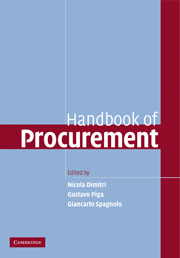Book contents
- Frontmatter
- Contents
- List of figures
- List of tables
- List of contributors
- Preface
- Part I Preliminary Issues
- Part II General Strategic Principles
- Part III Competitive Tendering Strategies
- Part IV Attracting and Screening Participants
- Part V Preventing Collusion and Corruption
- 14 Preventing collusion in procurement
- 15 Bidding rings and the design of anti-collusive measures for auctions and procurements
- 16 Corruption in procurement auctions
- Part VI Dynamic Forces and Innovation
- Glossary
- Index
- References
16 - Corruption in procurement auctions
Published online by Cambridge University Press: 04 November 2009
- Frontmatter
- Contents
- List of figures
- List of tables
- List of contributors
- Preface
- Part I Preliminary Issues
- Part II General Strategic Principles
- Part III Competitive Tendering Strategies
- Part IV Attracting and Screening Participants
- Part V Preventing Collusion and Corruption
- 14 Preventing collusion in procurement
- 15 Bidding rings and the design of anti-collusive measures for auctions and procurements
- 16 Corruption in procurement auctions
- Part VI Dynamic Forces and Innovation
- Glossary
- Index
- References
Summary
Introduction
Auctions are an efficient mechanism to procure. This is why they have been used for centuries and are being used ever more frequently. But they are not immune to manipulations through collusion and corruption. Collusion means that bidders coordinate their actions with the intention to increase the price. Corruption means that the person who runs the auction, the auctioneer, twists the auction rules in favor of some bidder(s) in exchange for bribes. Corruption and collusion are sometimes interlinked. However, in this chapter, we focus exclusively on corruption.
We describe with the term corruption all kinds of behavior where a person who is in a position of trust misuses this position to her own advantage. In its procurement guidelines, the World Bank defines a “corrupt practice” as “The offering, giving, receiving, or soliciting, directly or indirectly, of any thing of value to influence the action of a public official in the procurement process or in contract execution”. In the specific circumstances of an auction, the person of trust is the auctioneer, who acts on behalf of the procurer, and the bidders who have pledged to play by the rules. Obviously, if the procurer and the auctioneer are one and the same person, there is no room for corruption.
- Type
- Chapter
- Information
- Handbook of Procurement , pp. 412 - 430Publisher: Cambridge University PressPrint publication year: 2006
References
- 20
- Cited by

